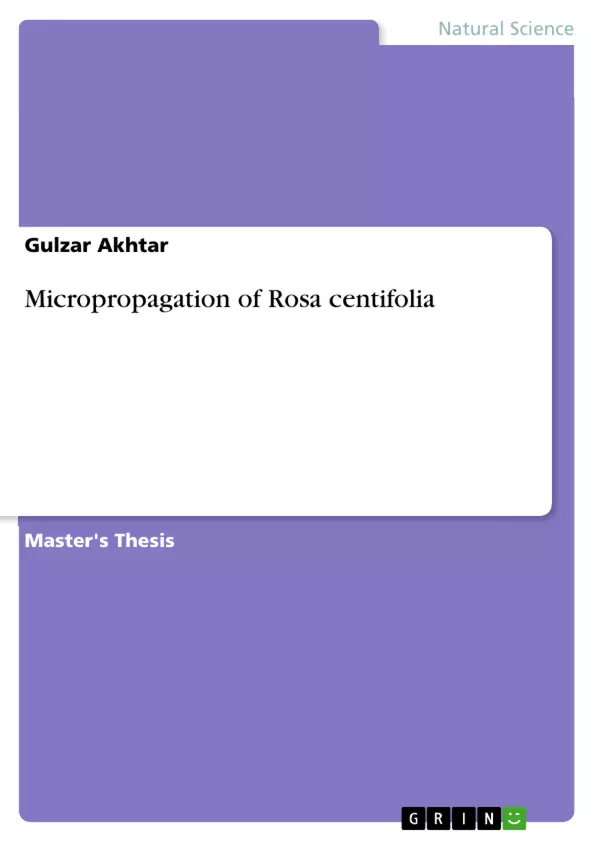The present study was conducted for regeneration of Rosa centifolia and reduction of oxidative browning. Shoot tips with axillary buds were used as explant. The explants were surface sterilized with 70% alcohol for 4 minutes and 5% bleach for 4 minutes followed by three washing with autoclaved double distilled water After that the explants were cultured on MS media (Murashige and skoog,1962) supplemented with different concentration of BAP (Benzyladenine) and NAA (Naphthalene acetic acid). Effect of different concentrations of BAP (1.5 mg/l, 3 mg/l) alone and in combination with NAA (0.5 mg/l) for shoot induction. BAP and NAA (3.0 mg/l +1.5 mg/l respectively) gives the good results for shooting. the effect of NAA (1.5 mg/l, 3 mg/l) alone and in combination with BAP (0.5 mg/l) for root induction was examined. NAA and BAP (3.0 mg/l +1.5 mg/l respectively) gives the good results for rooting. After rooting plants were acclimatized and successfully transferred to the greenhouse. To control the oxidative browning in Rosa centifolia different treatments (charcoal, charcoal + running water, stirring in antioxidant solution of citric acid and ascorbic acid) were used. But the charcoal with the running water gives the good results.
Inhaltsverzeichnis (Table of Contents)
- INTRODUCTION
- REVIEW OF LITERATURE
- Other ornamental plants
- Fruit plants
- MATERIALS AND METHODS
- Explant collection
- Preparation of medium
- Sterilization of explant and culture
- Browning
- Media used
- Media for browning
- Media for shooting
- Media for rooting
- Cultural conditions
- Data collection
- Shoot multiplication
- Number of days to sprout
- Number of laterals
- Shoots length (cm)
- Number of leaves/plant
- Root initiation
- Number of days to emerge roots
- Number of roots
- Root length (cm)
- Browning
- Shoot multiplication
- RESULTS AND DISCUSSION
- Number of days to initiate shoots
- Number of laterals
- Number of leaves/explant
- Shoot length
- Number of days to emerge roots
- Number of roots
- Root length
- Acclimatization
- Browning control
- SUMMARY
- Conclusion
- LITARATURE CITED
Zielsetzung und Themenschwerpunkte (Objectives and Key Themes)
This thesis explores the micropropagation of Rosa centifolia, aiming to optimize in vitro techniques for efficient multiplication and root initiation. The research investigates the effects of various growth regulators and cultural conditions on the growth and development of the plant.- The impact of different growth regulators on shoot multiplication and root development
- Optimization of media composition for shoot and root induction
- Evaluation of the influence of various cultural conditions on plant growth and development
- Acclimatization of micropropagated plants to ex vitro conditions
- Control of browning, a common problem in micropropagation
Zusammenfassung der Kapitel (Chapter Summaries)
The initial chapters provide a comprehensive introduction to Rosa centifolia and its significance in horticulture. The review of literature delves into established micropropagation techniques and their applications in ornamental plants, including Rosa centifolia. Chapter 3 outlines the materials and methods used in the study, focusing on the procedures for explant collection, medium preparation, sterilization, browning control, and data collection. The core results and discussions are presented in Chapter 4, analyzing the impact of various growth regulators on shoot emergence, lateral shoot formation, leaf production, shoot length, root emergence, root number, root length, and acclimatization. The chapter also explores browning control strategies. The summary in Chapter 5 provides a comprehensive overview of the findings, highlighting the conclusions drawn from the research.Schlüsselwörter (Keywords)
The study focuses on the micropropagation of Rosa centifolia, exploring key topics such as in vitro culture, shoot multiplication, root induction, growth regulators, cultural conditions, acclimatization, and browning control.- Quote paper
- Gulzar Akhtar (Author), 2009, Micropropagation of Rosa centifolia, Munich, GRIN Verlag, https://www.grin.com/document/286650



